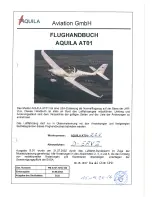
82002-PG-F
ST3400 TAWS/RMI PILOT’S GUIDE
PAGE 46
Cautions are always designed to occur prior to warnings during steady-
state flight. There are exceptions such as during turning flights into terrain
or when there are significant changes in vertical speed when close to
terrain. Under these conditions a Warning may be received without a
Caution.
When an alert first occurs, REL is automatically displayed, in ARC view,
at an appropriate range (minimum of 5 nm) to put the terrain conflict on
the screen as long as the pilot has not previously selected TAWS INH.
After the alert occurs the pilot may select other display modes (such as
PRED) and/or other ranges.
The terrain display always shows all terrain – not only that which
represents actual conflicts. For instance if two cells are threats
simultaneously, both cells will be visible on the ST3400
but only the
closest one will be circled
. There may be other areas of conflict!
In the illustration below notice that the alert is on a green cell. This is
occurring because the aircraft is descending yet the cell is still well below
the aircraft’s current altitude. In REL display any color cell may produce
an alert. In the PRED display only YEL or RED cells may produce alerts.
A RED annunciator indicates a WARNING
82002-PG-F
ST3400 TAWS/RMI PILOT’S GUIDE
PAGE 47
Responding to an Alert
Every alert should be considered valid and requires appropriate action.
An AMBER annunciator indicates CAUTION and
requires immediate pilot attention.
A RED annunciator indicates a WARNING and requires
immediate aggressive pilot action.
Pilot reactions to alerts and warnings differ according to weather
conditions, visibility, type of warning, phase of flight and aircraft
performance considerations. Pilots should be thoroughly familiar with
FAA, company, or other approved operational procedures as required by
their aircraft and type of operation
Pilots should train to react properly to all alerts, cautions and warnings, just
as one would train to react to an aircraft stall, engine failure or any other
emergency situation.
RESPONDING TO AN ALERT
Text / Alert
Source
Pilot Action
Caution Terrain
(FLTA caution)
FLTA
If level, apply power, establish a climb
attitude, and climb out of the alert.
Check position on terrain display.
If descending, apply power and level off.
If caution continues, apply power and
establish a climb attitude.
Don’t Sink
(GPWS caution)
ALAT
Immediately level wings, apply full power,
and establish a climb attitude.
Five Hundred
Callout
500’ AGL or above runway
Glide Slope
(GPWS caution)
EDGSD
Arrest descent rate and rejoin the glide
slope.
Pull Up
(GPWS warning)
ERD
ECRTNL
ECRTL
Disengage autopilot/immediately level
wings.
Apply full power, establish a climb attitude.
Continue maneuver until alert ceases or
terrain clearance is assured.
Sink Rate
(GPWS caution)
ERD
Arrest sink rate and fly out of the alert area







































